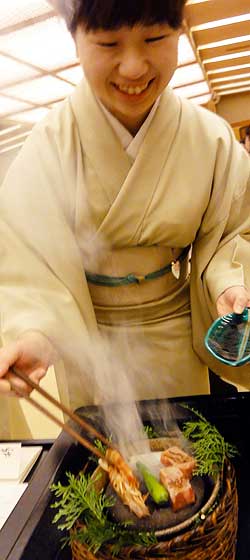
You are lucky indeed if you ever get the opportunity to experience a kaiseki meal, especially one in a ryokan, a traditional Japanese inn. You’ll enjoy a long, relaxed procession of delicacies in small portions, exquisitely presented, and usually specific to the season.
I had the incredible good fortune to indulge in a week of kaiseki lunches and dinners in Japan. One meal featured tofu in many forms. One featured tempura. Another was Buddhist vegetarian. The most breathtaking were those served at Yagyuno Sho Ryokan in Shuzenji, on Japan’s Izu peninsula.
I’m in awe of Takashi Shibayama, Yagyuno Sho’s chef, who showcased an endless variety of glorious creations in perfect balance, meal after meal. As you’ll see in the following photos, his magnificent presentations are the synergetic result of his ravishing edible works of art complemented by precious serving pieces, and owe a nod to whimsy.
These photos are from a single kaiseki dinner titled “A Picnic Under the Cherry Blossoms.” A menu was provided in Japanese calligraphy, along with an attempted English translation.
One Kaiseki dinner
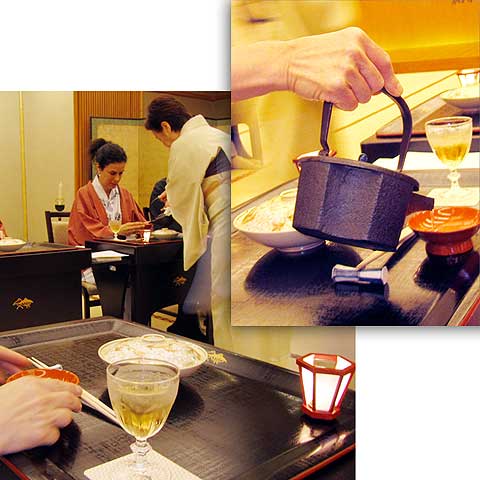
The meal begins with a treasured sake poured from iron pots into flat red lacquer bowls. Just a sip, it’s a fruity and fervent taste bud wakeup call, accompanied by a tiny red lantern glowing with a short-lived candle. In a deeply-textured covered bowl, a surprise awaits.
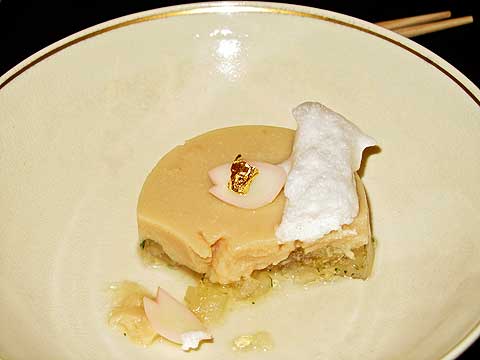
Surprise indeed! Who would expect haute cuisine—and foie gras, no less? It’s a silky paté “with white radish agar (moon) and salty meringue (cloud),” a garnish of gold foil and cherry blossom petals—an edible haiku in beige. How about…
Fat goose flies in spring
Cherry blooms, moon in cloud, his
Liver is dinner
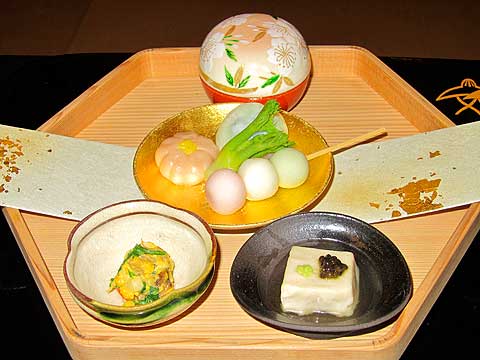
A wooden tray is presented. Paradoxically called “Simple Meal,” it is anything but. In the gorgeous little covered bowl: “bamboo shoot, udo, butterbur dressed with young Japanese pepper and moso.” In my excitement, I forget to take a picture of the opened bowl. The central plate of gold-leaf floats on a gold-leaf-spattered strip of handmade paper. It holds “sushi balls, picnic dumpling, and dried wheat.” On the black ceramic dish, sesame seed tofu with caviar. In the beige: “rape blossoms with dried wheat gluten.”
Gluten makes frequent appearances. Itself bland with a pleasant, chewy texture, it’s an excellent sponge and carrier of flavors.
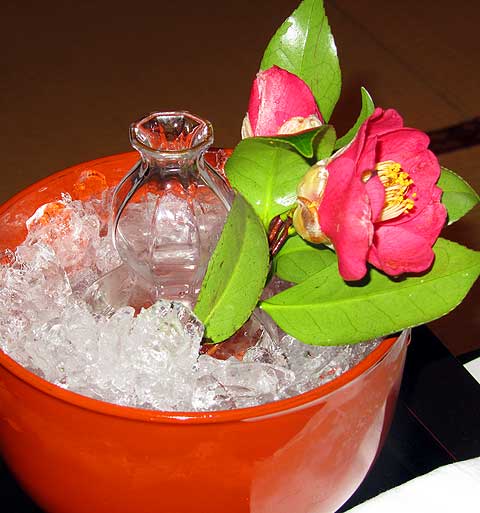
Our cold sake arrives in crystal glass decanters deep in red lacquer bowls of ice and flowers. You must not pour your own sake—but look after your neighbors, and make sure their cups are full. I can’t help noticing the uniformity of the ice—crushed to perfection.
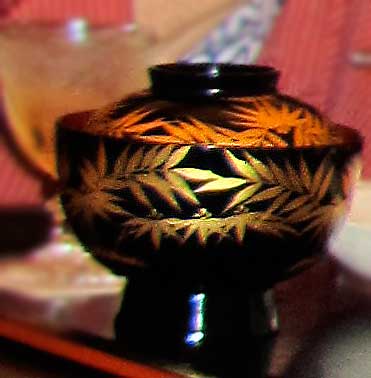
A small “clear soup with red sea bream dumpling” is in a large lacquer bowl, black with gold bamboo on the outside, dark red on the inside. We are reminded that we are not expected to like or consume everything, but I can’t help myself. I do and I do.
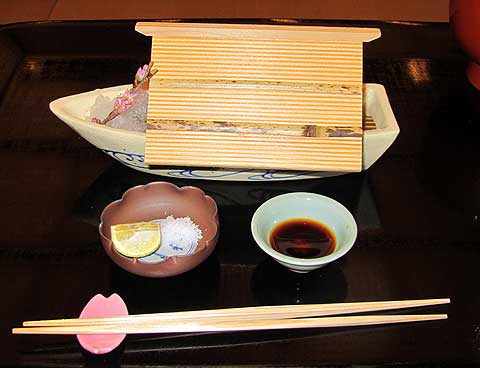
Boat-shaped dishes with tantalizing covers are set before us. Our chopstick rests are swapped for porcelain cherry blossom petals. We begin to wonder how large the ryokan’s tableware pantry is.
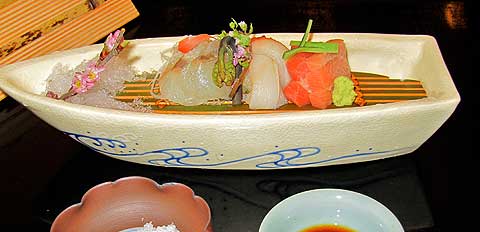
Lifting the bamboo roofs, we discover sashimi: tuna, sole, and horse clam. We’re gently instructed on which condiment highlights each fish. All the garnishes are edible, including the cherry blossoms.
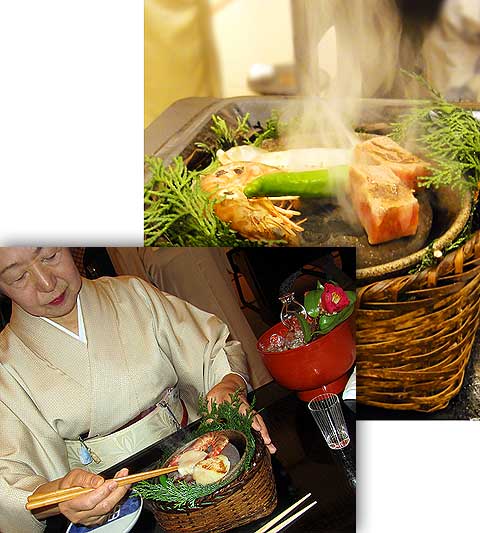
Done with delicate for the moment, a hot rock is brought to each of us wrapped in fresh juniper branches in a wicker basket. We are served at meals by the same women who look after our rooms, and now they cook for us. Izu beef, shrimp, squid, and a green chili pepper are placed on each heated stone, which sears the food in a minute or two. I get two fat scallops instead of beef.
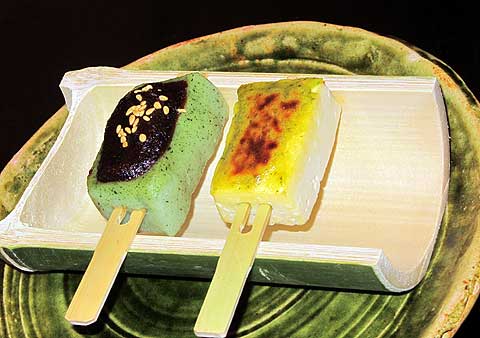
These colorful popsicles are called dengaku: “grilled tofu and dried wheat gluten on skewers coated with miso glaze.” They’re balanced on a bamboo cane on a rough plate the color of bamboo.The plate is a mossy pond whose surface is disturbed by koi kissing air.
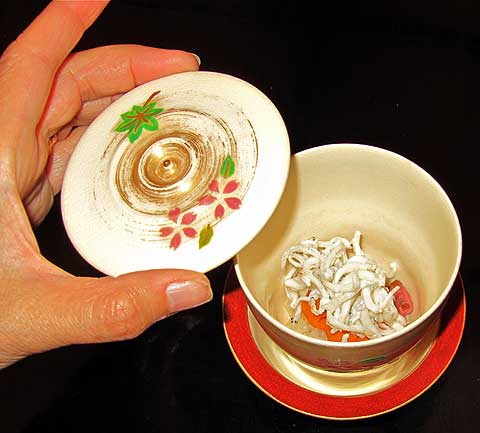
Steamed icefish on sea urchin. The tiny white fish are complete with little eyes. The beautiful bowl and urchin-colored saucer are paper thin. We’ve learned to recover our bowls when finished with a dish. The staring fish and raw sea urchin gonads are too much for some; their bowls are quickly covered.
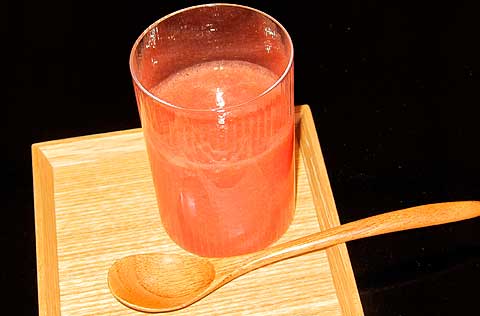
“100% fresh tomato juice.” It is thick enough to eat with a wooden spoon, and very cold in a crystal shot glass. A concentrated flavor break between two hot dishes.
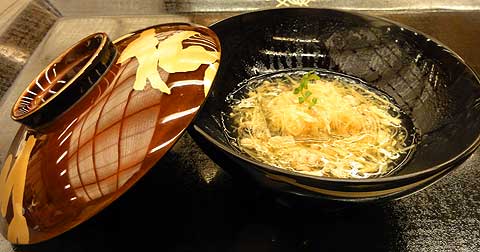
In a brown and gold covered lacquer bowl, “deep fried bamboo shoot with liquid starch.” There must be a better translation for “liquid starch,” but the Japanese haven’t found it. Enriched broth? Thickened consommé?
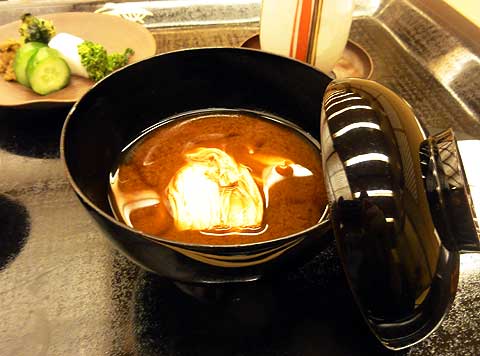
This one has an element of mystery. The menu translation is “dark brawn miso soup with bean curd tofu skin.” Is that dark brown soup or dark prawn soup? Either way, it is delicious. Ahhh… another bottle of sake, please!
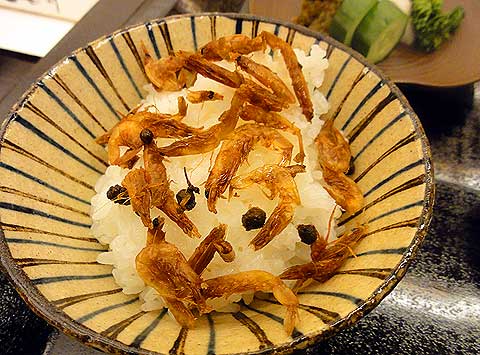
Finally, and always last, comes the rice. It’s in a stunning stoneware bowl with an accompaniment of cooked small shrimp. A plate of pickled vegetables on the side.
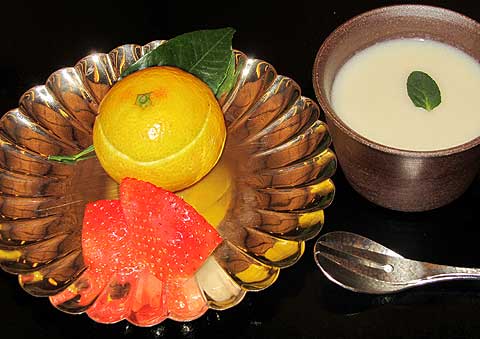
And for dessert, something small, cold, and light on a silver dish. “Sweet summer yellow orange,” a strawberry for contrast, and a sweet drink made from fermented rice with soybean milk pudding.
Breakfasts at the ryokan are just as spectacular, but served expeditiously, in well over a dozen different little plates and bowls. I’ll spare you the photos.
Over five dramatic meals on the property, I never saw the same serving piece more than once. And all of this was managed just days after the earthquake and tsunami, under the threat of nuclear meltdown, between scheduled rolling blackouts. Praise and thanks to Yagyuno Sho Ryokan and its wonderful chef and staff.
* * *
Read about Japan’s complicated shoe rules.
Read what it was like to be in Japan’s 9.0 earthquake.




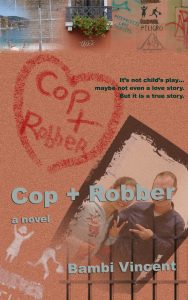
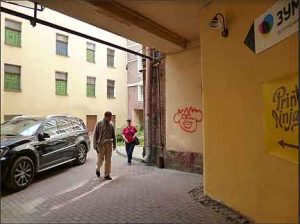
4 Comments
[…] Read about Japan’s complicated shoe rules. Read about a Japanese kaiseki dinner. […]
[…] Read also: Japan Kaiseki Dinner. […]
I’m full all over again.
Award winning haiku.
Yes! These photos and your words have brought it all back to me. Makes me want to return to Japan. To think that all these dishes were ONE meal. You really paid attention to detail–thanks for renewing memories.